NevadaToday
College of Engineering Dean Manos Maragakis: A retrospective on a distinguished tenure Maragakis has served as dean since 2008, will transition to faculty at end of June
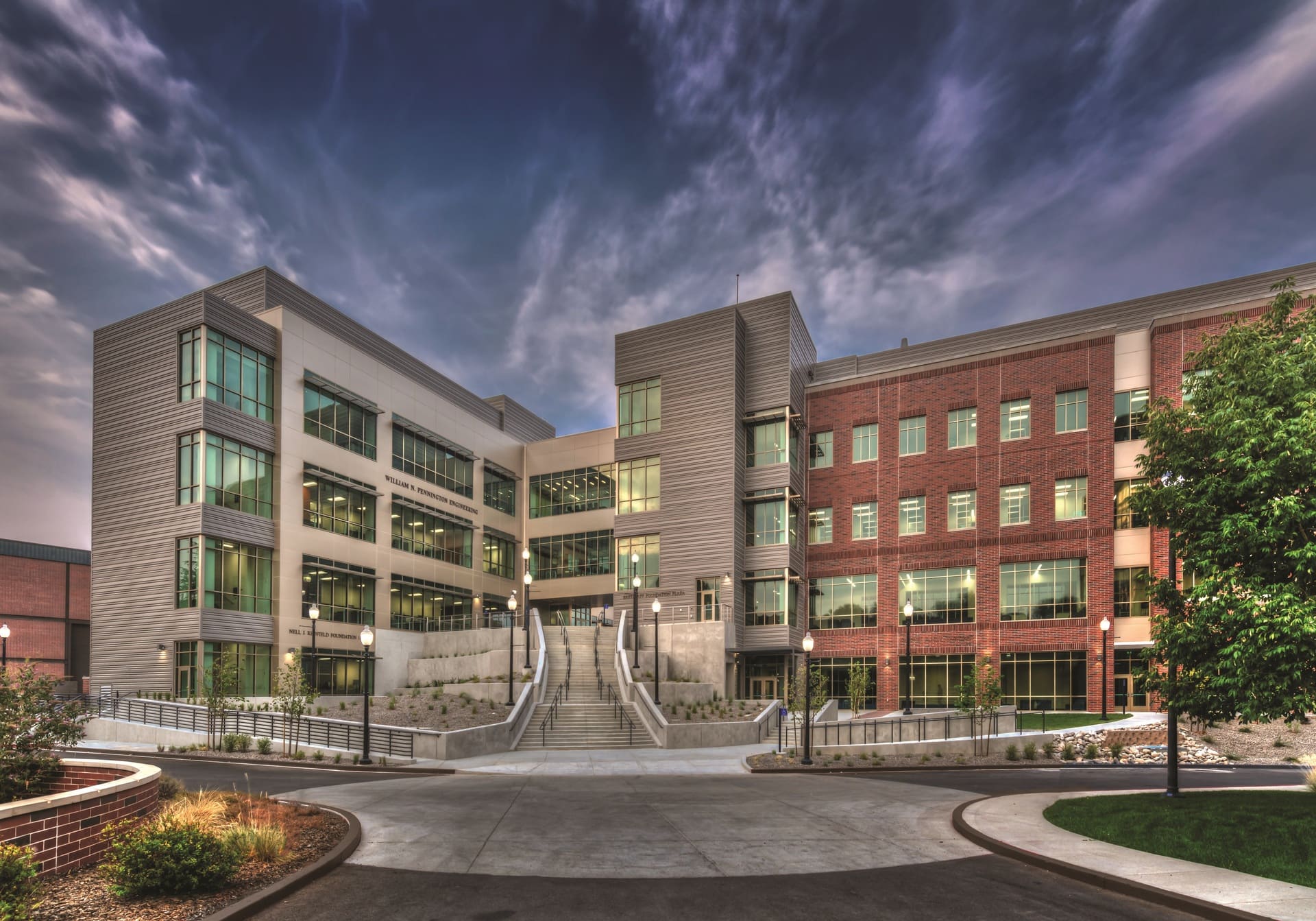
College of Engineering Dean Manos Maragakis: A retrospective on a distinguished tenure
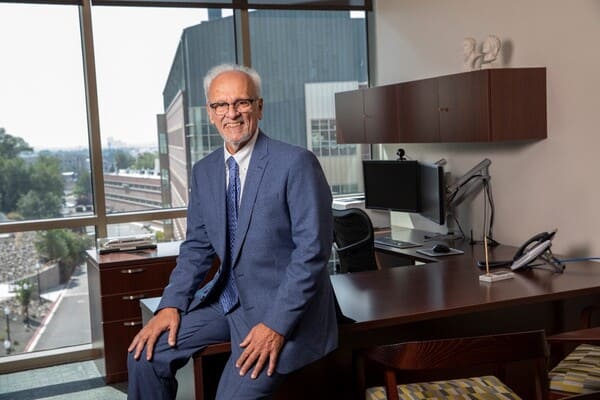
A mix of modesty and friendly bravado, a serious side that's all business and a side that's exudes dry humor set off by a wry smile and a hearty laugh – Manos Maragakis has a balance in life that enables him to create successful programs and collaborations, even with his fiercest competitors. It's a balance fueled by seemingly ceaseless energy that has fostered a multitude of successes and a culture of excellence for the College of Engineering.
"I have been blessed with the talent, support and hard work of my colleagues to achieve all the strategic goals we set when I assumed the great responsibility of leading this College," Maragakis said. “The secret to the success was the development of our strategic plan. Today, I feel fortunate to say that all of our metrics for measuring our success have been met or exceeded.
"I feel my mission has been accomplished, the College is stronger and has developed into a premium and comprehensive engineering program, and now it is an excellent opportunity for me to step down."
Maragakis joined the University of Nevada, Reno’s College of Engineering in 1984, was named chair of the Department of Civil & Environmental Engineering in 1994, and in 2008 became the interim dean. On March 1, 2009, he was officially named dean of the College. This June, Maragakis will step down from this role to once again serve as a professor in the College.
“I have been honored to lead the College for 14 years,” Maragakis said. “The College has grown in every aspect of its mission. Two new buildings, the renovated Palmer Engineering building, more academic programs and the new resources made available through differential fees have given our students the opportunity to enhance their academic experience. They can excel through state-of-the-art advising and tutoring, and our career services prepare them for a lifetime of fulfilling, high-paying employment. And as a result of our advancements and excellence in research, all of our rankings-eligible programs are ranked by the U.S. News & World Report.”
He added, “The College has a commanding presence in our region and on the national scene. We now have an opportunity to take the College to the next level.”
When Maragakis took the role of dean, he began enacting a vision for the College that was founded on three strategic objectives: Provide a globally competitive engineering and computer science education; perform cutting-edge research; and engage in high-impact outreach activities. As a result, the College has experienced what may be the most productive and illustrious period in its history.
“As a faculty member, department chair and dean, over the course of one of the most distinguished careers in our history, Manos has helped lift our University in every possible way.”
President Brian Sandoval
“As Dean, Manos took a college that was already one of the best on our campus and provided the leadership that has made it a rising force on a national scale,” University President Brian Sandoval said. “Manos was more than a leader in the College of Engineering. He was the voice that beckoned his students, colleagues, alumni and friends in the community to always not just dream about the future, but to make it a reality through coherent planning, collaborative relationships both locally and nationally that define the college to this day, and an ability to ask people for that extra 10 percent of effort and belief in a unifying vision that can often come to define the extraordinary. As a faculty member, department chair and dean, over the course of one of the most distinguished careers in our history, Manos has helped lift our University in every possible way.”
Chapter 1
Strategic objective: a globally competitive engineering and computer science education
Growth in enrollment, high quality of instruction
Under Maragakis’s leadership, the College of Engineering has experienced tremendous growth. Undergraduate enrollment has doubled, while Ph.D. enrollment has more than doubled to reach a record number of 220 students. To ensure students receive the highest education possible, faculty positions have also increased by 65%. Through this growth, the College’s programs have developed in prestige. In 2022, for a third year in a row, all ranking-eligible graduate programs in the College received rankings by the U.S. News & World Report. As an illustration of the College’s trajectory, in 2009, only the civil engineering program and the College itself were ranked. Now, eight programs and the College are ranked.
“Our faculty and students engage in cutting-edge research funded by selective and competitive grants, and high-quality engagement activities enable us to serve our region, nation and world,” Maragakis said when the rankings were released. “These rankings are the result of the excellence and tireless efforts of our students, faculty and staff.”
Quality of instruction
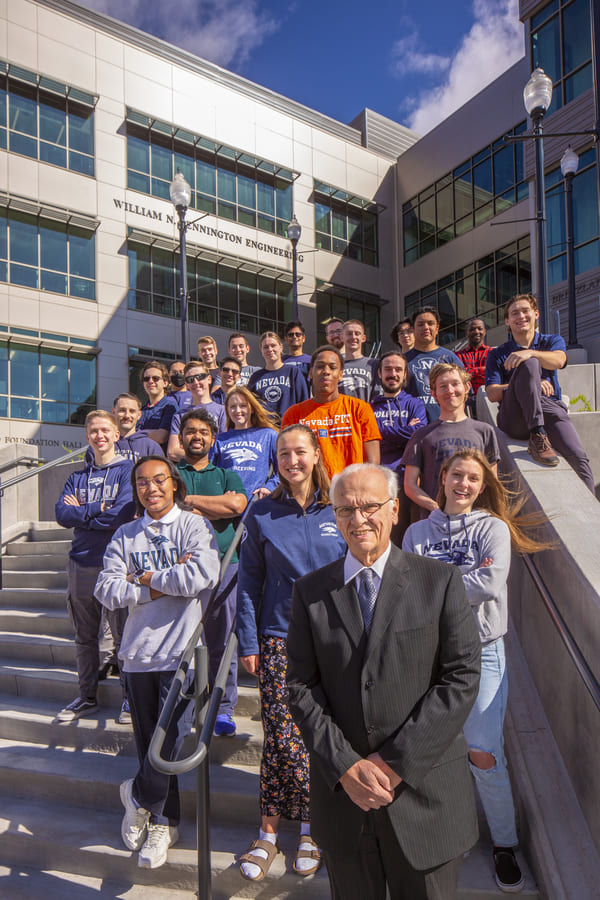
The impact Maragakis has had on the quality of instruction is perhaps best illustrated through a story Candice Bauer shared. Now the Director of Student Affairs and Assessment in the College of Engineering, when Maragakis became interim dean in 2008, Bauer was rising in esteem in the mechanical engineering community, and she had recently been elected Vice President of the American Society of Mechanical Engineers (ASME), a prestigious post. However, back at the University, because she was hired as a lecturer, she was not afforded the resources she needed to thrive.
“As a lecturer, they wouldn’t give me an office, so I was actually using the ASME storage closet in Palmer [Engineering building] as my office. They wouldn’t give me a desk, so I went and purchased my own desk. I wasn’t allowed to have business cards, so I had to make my own business cards,” Bauer said. “Well, then along comes Manos. Kwang Kim—the mechanical engineering chair at the time—saw me climbing through the ranks of ASME. He had a conversation about me with Manos when he became interim dean, and the next thing I know I’m in Manos’s office. And Manos said to me, ‘So, it sounds like we have a hidden gem.’
“That was my big break. From there, he created support for my career.”
As a result of her dedication to the profession and with the full backing of the College, Bauer has since gone on to be recognized for the quality of her instruction. In 2014, she was named the University’s F. Donald Tibbitts Distinguished Teacher Award winner and in 2018 she received the inaugural Paul and Judy Bible Excellence in Teaching Award.
“Most people use the catchphrase the pursuit of excellence, but for Manos, that's the minimum. That’s the beginning. It's the start, and that's the key to the visionary leadership that we have had with him.”
Candice Bauer
“Most people use the catchphrase the pursuit of excellence, but for Manos, that's the minimum. That’s the beginning. It's the start, and that's the key to the visionary leadership that we have had with him,” Bauer said. “As part of a group that is sometimes invalidated or marginalized, he gave us more than a voice. He listened to us, and he helped us.”
Like Bauer, Teaching Assistant Professor Ann-Marie Vollstedt has flourished since she first joined the College as a full-time lecturer in 2013. She directs E-FIT, a one-credit course that prepares incoming students for college life, and she designed and teaches one of the College’s signature courses: ENGR 100.
“Manos had a vision to offer a multidisciplinary class for all incoming engineering students in order to excite them about engineering and so that they could learn about the disciplines offered at UNR,” Vollstedt said. “This is the ENGR 100 course, which became one of the main courses I was able to help design and teach.”
Between these courses, a statics course she teaches and her role in the CREATE Scholars program, each year Vollstedt helps 1,000 students on their engineering journey. Vollstedt’s teaching philosophy begins with a desire to reach students where they are and to inspire them to embrace engineering and the possibilities it opens up.
Innovation Day: Showcasing student success
Each year, all engineering graduating seniors work in teams on senior capstone projects. Together, they design solutions to real-world problems. From idea to prototype, the process allows students to draw on four years’ worth of engineering coursework to bring theory to life. In 2021, 443 students on 105 teams completed capstone projects. One of Maragakis’s original visions for the College when he took office, the annual Innovation Day is a showcase of these capstone projects.

“When they graduate, our students’ hands-on learning experiences have enabled them to move ideas from vision to reality, and their ingenuity, as demonstrated on Innovation Day, is truly remarkable,” Maragakis said of Innovation Day. “Engineering is all about innovation and ingenuity, and we are proud of our students’ accomplishments and dedication to improving the world.”
Often, the projects students work on are requests from industry and campus partners trying to solve real-world problems. For example, in 2021, Assistant Professor Rashed Khan of the Department of Chemical and Materials Engineering submitted a project idea that one of the senior capstone teams accepted.
Khan recounted the experience:
“The capstone group [team CHE 07, microprobe] accepted one of the real-world problems that experimental research labs face every day, i.e., expensive supplies,” Khan said. “In collaboration with Mayo Clinic (MN), we investigated targeted drug delivery solutions to treat brain cancer, harnessing the computational neurochemical models developed in our lab. We reached a point where the lab needed 20 drug delivery probes per week for the experimental validation. Costly off-the-shelf probes did not seem a sustainable solution, especially at the lab scale, where more trials are required in a brief period.
“The experiential learning opportunities and the interaction through Innovation Day are truly remarkable for students and echo what Dean Dr. Maragakis had envisioned.”
Rashed Khan on Innovation Day
“So, we submitted a project idea to Dr. Coronella – the CHE 482 (Design Project) instructor, asking senior CHE students to accept this challenge and bring a solution utilizing chemical engineering knowledge and problem-solving skills. The capstone group successfully demonstrated a delivery probe that would cost only $3 per piece and approximately 250 times less than the commercially available ones. Two students (Braden Norris and Gerra Licup) further investigated it for small business initiatives that open up new-career initiatives. The experiential learning opportunities and the interaction through Innovation Day are truly remarkable for students and echo what Dean Dr. Maragakis had envisioned."
While Innovation Day is typically held annually in Lawlor Events Center so industry partners and K-12 schools can view the projects, last year, the event took a digital format. Students, demonstrating their abiding ability to overcome new challenges, produced “lightning talk” videos on their projects. Explore the 2021 Innovation Day projects.
Differential fees make a difference
Recognizing the importance of providing students support through every facet of their academic careers, Maragakis prepared the proposal, presented it to the students, gained their support and the College initiated a differential fees program.
"The differential fee program brings the needed resources and a productive partnership among faculty and students to ensure that our students graduate with a globally competitive engineering and computer science education," he said.
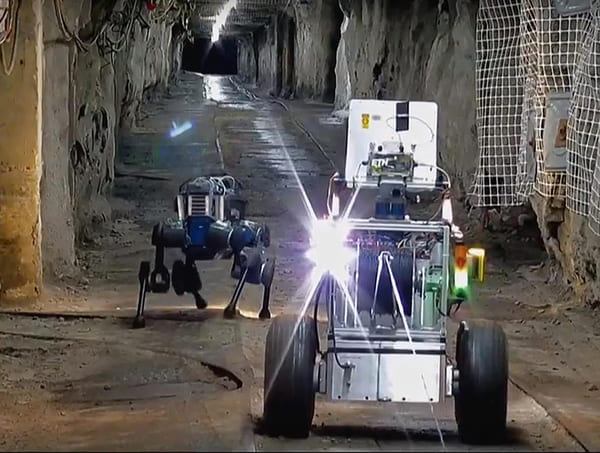
The funds generated have been used to provide students with enhanced support services. An annual accounting of these funds allows full transparency of the many ways the program has improved the student experience on campus. To ensure the funds are used in ways that match the needs of students, students from each department serve on the differential fees committee. Areas supported through differential fees include: the Engineering Tutoring Center; the Engineering Advising Center; the Engineering Leadership Council, which supports Engineering student clubs; Engineering Career Services; the Engineering Research Office; and the web and marketing specialist in the College. Funding from the differential fees program is also used to support graduate research assistantships and student scholarships.
"From a personal point of view I am very proud to have introduced this idea 14 years ago, and have written the proposal which was approved by the regents in 2010," he said. "By the way, this proposal has been used as the basis for other programs on our campus and other state campuses to establish differential fee programs."
A culture of inclusivity
Responsive academic offerings
In addition to initiating individual courses like ENGR 100, the College has also brought online a number of new minors, graduate certificates and programs in recent years to meet emerging needs. With more than 30 engineering degrees, minors and certificate programs, the robust offerings provide ample opportunities for students to fulfill their academic and career goals.
Recent additions include:
- Aerospace Engineering (Minor)
- Biomedical Engineering (Minor, B.S., M.S., Ph.D.)
- Cybersecurity (M.S.)
- Engineering Education (Ph.D.)
- Nuclear Packaging (Graduate Certificate)
- Sustainability (Minor)
- Unmanned Autonomous Systems (Minor)
- Fast-track academic programs (B.A./M.S. and B.A./MBA in five years)
In 2019, the University shared the findings from its campus climate survey. Designed to “measure inclusiveness and feelings of belonging among all University of Nevada, Reno students, faculty and staff,” the survey revealed that 21 percent of respondents had experienced exclusionary, intimidating, offensive or hostile conduct. In light of this finding, College of Engineering Dean Manos Maragakis and Assistant Professor Kelly Cross immediately responded by establishing the College of Engineering’s Diversity, Equity, and Inclusion Committee.
“Because of the complexity of the work they do, engineers and computer scientists are most effective when they collaborate effectively,” Maragakis said. “Professionally, it is critically important that everyone in the classroom and the laboratory feels welcome to share their ideas. Equally important, though, is our obligation to be good citizens, acting with empathy, understanding and compassion for everyone in our global community. The College of Engineering Diversity, Equity, and Inclusion Committee seeks to provide resources and guidance that are key to professional and personal success.”
Equitable education for all: A new doctoral program in engineering education
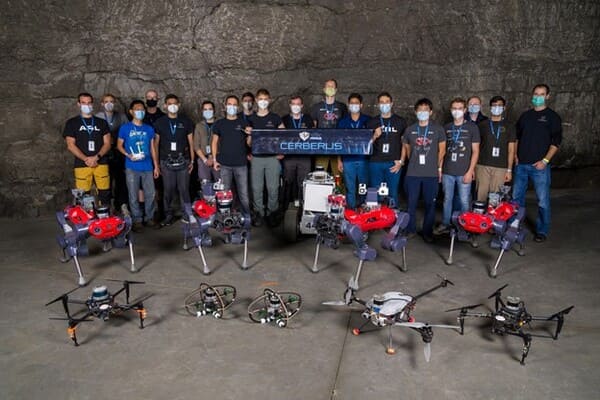
While the Diversity, Equity, and Inclusion Committee pursues its four strategic goals, the College has also established a doctoral program in engineering education. Launched in Fall 2020 and led by Associate Professor Adam Kirn and Assistant Professor Kelly Cross, the program is designed to prepare graduates for research, academic and other demanding careers in engineering education from pre-kindergarten classrooms to workforce development. Because of its focus on pedagogical strategies and approaches that nurture all students, diversity, equity and inclusion are key to its success.
“The Ph.D. in engineering education is built around diversity, inclusion and equity,” Kirn, who serves as program director, explained. “The question we are trying to answer is, ‘How do we incorporate a broad range of students in the process of learning engineering skills and principles?’ How we answer that question in our research and labs will translate to practices in classrooms throughout our state and beyond.”
Cross added, “Diversity, equity and inclusion are foundational components of the program. Our students will learn how to incorporate DEI concepts into all their professional activities including teaching, research and service. Importantly, our students will also learn to evaluate DEI goals and activities.”
Chapter two
Strategic objective: cutting-edge research
Serving students, improving the world
Recognizing the critical importance of research as an avenue for instruction and a tool for the College to make a positive impact locally and globally, Maragakis established the Engineering Research Office. The dedicated professionals provide support for grant applications within the College, from preplanning through the management of funds. As a result of this support, grant funding has increased over the years.
“As a result of our team’s hard work, the dedication and creativity of the engineering faculty, and most importantly, Manos’s vision and enduring support, College of Engineering research awards have doubled since 2017 and topped $20 million in 2020.”
Erika Hutton, Engineering Research Office
Erika Hutton, who serves as the Engineering Research Office Project Manager, said, “Manos recognized the value of a dedicated research office for Engineering and gave us the resources and autonomy we needed to create and grow that office. As a result of our team’s hard work, the dedication and creativity of the engineering faculty, and most importantly, Manos’s vision and enduring support, College of Engineering research awards have doubled since 2017 and topped $20 million in 2020.”
The research in the College ranges from the nanoscale up to regional earthquake engineering. Laboratories throughout the College provide opportunities for hands-on learning and research experience for undergraduates, graduate students, and postdoctoral scholars. In addition to offering critical research experience, these labs focus on the wellbeing of the community the University serves. Research conducted in the College’s labs serve the public interest, for example, by advancing pavement technologies in conjunction with the Nevada Department of Transportation, securing our cyber networks through research that has earned the University designation as a Center of Academic Excellence in Cyber Defense (CAE-CD) from the National Security Agency and the Department of Homeland Security, and working with the Department of Energy and NV Energy to optimize solar energy capacity
During the COVID-19 pandemic, faculty and students harnessed their resources and skills to join the fight. In the earliest days of the pandemic, Department of Computer Science and Engineering Associate Professor David Feil-Seifer used 3D printers to produce personal protective equipment; Department of Mechanical Engineering Associate Professor James Hanna was part of a team that more accurately determined the shape of the SARS-CoV-2 virus particle, key to understanding how the virus moves and attacks; Hanna’s colleague, Assistant Professor Aditya Nair, helped the City of Reno refine its COVID-19 Risk Meter; in collaboration with the School of Medicine, Department of Chemical and Materials Engineering Professor Mano Misra developed a SARS-CoV-2 test that provides results in 30 seconds, while Associate Professor Ravi Subramanian developed a titanium and ultraviolet light combination to disinfect surfaces; and in the environmental engineering laboratory of Foundation Professor, Ralph E. and Rose A. Hoeper Engineering Professor and Department of Civil & Environmental Engineering Chair Krishna Pagilla, researchers conducted wastewater testing to determine the prevalence of the SARS-CoV-2 virus in the Truckee Meadows community, including the Delta variant. Grants to support this wastewater research have totaled $3.3 million and counting.
"I have been proud and excited to see so many initiatives completed with major successes in all areas of our academic mission: first-class education, cutting edge research and impactful outreach to our region, our state and eventually the nation and the world," Maragakis said. "All these initiatives advanced our College to measurable national prominence and will have a major impact on future advancements. But I believe that two in particular will have long lasting impact in the distant future of our College: The establishment of our differential fee program and the new engineering building."
World-class facilities
To achieve high-impact research outcomes, students and faculty require state-of-the-art facilities. To that end, Maragakis pursued renovations to existing infrastructure and the construction of two new buildings—the Earthquake Engineering Laboratory and the William N. Pennington Engineering Building.
Earthquake engineering
Shake tables
In 1999, then the Department of Civil and Environmental Engineering Chair, Maragakis recruited renowned earthquake engineering researcher Ian Buckle to join civil engineering. At the time, the earthquake engineering research program was on the rise, with a dedicated and distinguished cadre of professors already in place.
Soon, Buckle and Maragakis, along with the other professors in the program, began expanding the earthquake engineering research capabilities at the University to build on this success. Instead of only working with two single-direction shake tables, a third and a fourth table were added, and all the tables – 14- by 14-foot, 27-ton hydraulically driven tables where engineers test large scale bridges and structures up to 100 tons in weight – were made biaxial, meaning they could move both north-south and east-west. In recounting this pivotal moment in the College’s history, Buckle said, “Having four large tables was unique in the United States, if not the world.”
With such an array of shake tables, Buckle was immediately able to perform experiments that could not have been done before. In one widely reported experiment, he placed six trucks on a curved bridge to see what effect, if any, the trucks would have on the performance of the bridge during an earthquake. The experiment’s surprising results – that the bridge performed better when weighted down with the vehicles – alleviated concerns Caltrans had about what would happen if one of its bridges were to experience a seismic event while completely loaded with vehicles.
Earthquake Engineering Laboratory
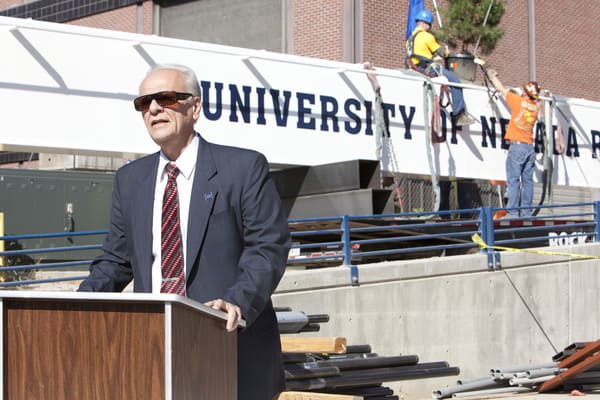
With the growing success of the earthquake engineering program, Maragakis (now dean) and Buckle began fundraising for a new building dedicated to earthquake engineering with additional floor space for the shake tables. After raising 80 percent of the funding through federal sources and receiving a 20 percent cost-share from the University, the Earthquake Engineering Laboratory Building (EEL) became a reality in 2014. Along the way, Buckle and the rest of the College’s Center for Civil Engineering Earthquake Research had to make strategic choices about how to configure the new space.
After an exhaustive planning process, the building was designed to accommodate the various needs of the program. The third level houses graduate students, the middle level has office space for professional staff, visitors and a conference room, and the first level houses the control room, offices for lab staff, a tool room, a transducer calibration room and a server room.

In addition to an auditorium for workshops, conferences, and seminars, the first floor also includes the focal point of the building: the high-bay laboratory, which houses the shake table array, where experiments with international implications are conducted by students and faculty alike.
“Fortunately, damaging earthquakes are rare,” Buckle said. “This fact is good for society, but not so good for studying the effects of earthquakes on the structures we build. Our Laboratory addresses this problem. We can have earthquakes on demand and test systems with innovative details. If someone has a bright idea today, we can test it tomorrow. And not have to wait fifty, maybe a hundred years, to find out it was not such a good idea.”
When the EEL opened, it also created space for another project that will keep the College at the forefront of the earthquake engineering field. In the final stages of construction, the so-called “soil box” is a biaxial, 19-layer, laminar box designed to address both halves of the equation in earthquake engineering.
“Traditionally, structural engineers work above the ground, ignoring the effect of soil,” Buckle said. “Meanwhile, geotechnical engineers focus on the soil below but ignore the building above. But the building and the soil are in fact one system.”
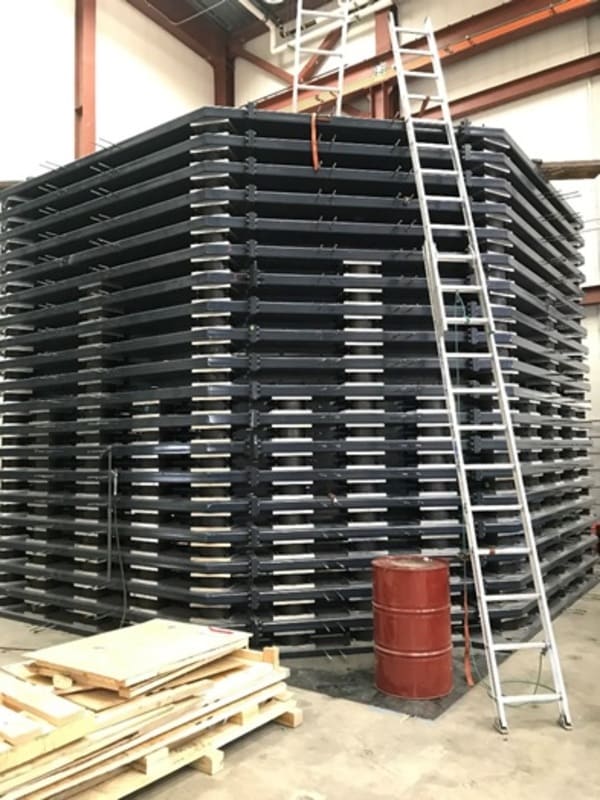
The behavior of the soil affects the building resting upon it, and the building’s weight affects the soil beneath it. To understand what a bridge, building or other structure would do in an earthquake requires knowing about ‘soil-structure interaction.’
“How do you do this kind of experiment? Soil is heavy, and its properties change with depth due to confinement,” Buckle said. “One way to simulate confined soil is to spin it in a centrifuge, but the size of an embedded structure is very small. Our approach is to build as-big-a-box of soil as we can afford and put it on as-big-a-shake table as we can afford.”
Upon its completion, the soil box will hold 400 tons of soil and be the largest of its kind in the United States. Sponsored by the Department of Energy, and a collaboration between the University, the Lawrence Berkeley National Laboratory in Berkeley, Calif., and the University of California, Davis, the many applications of the box include research to improve the seismic safety of nuclear facilities. As such, it supports the goal of the Department of Energy to secure public safety and represents another avenue for the researchers at the University to undertake ground-breaking research that raises the bar for the field.
Honoring the Past: Renovations to Palmer Engineering
In 2017, renovations to the Palmer Engineering building were completed. Built in 1941, Palmer was the last of the buildings on campus to be constructed in the Jeffersonian Revival style. Looking for ways to improve the research and educational opportunities for students and faculty, the College and the University worked with the University's Facilities Services and Design Team and the Nevada State Historic Preservation Office to honor the historic character of the building while preparing its interior spaces to serve the needs of the Department of Mechanical Engineering.
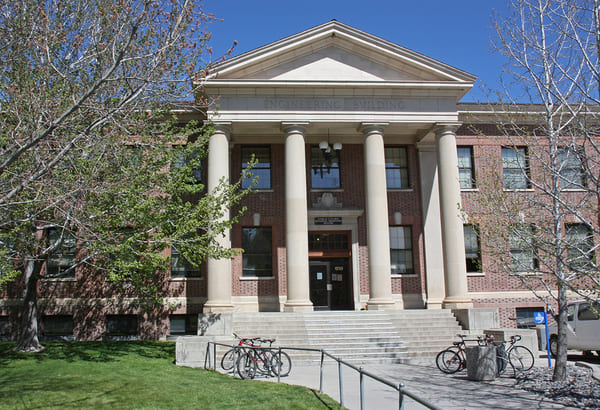
"The entirety of the effort was to shape this building into one of the most comprehensive, state-of-the-art learning and research spaces for our students and our faculty," Marc Johnson, who was then serving as University President, said upon completion of the renovations. "We did this in what has been traditionally an academic building. We've created something very special without changing the building's historical character."
In addition to seismic retrofitting, the building added student and faculty spaces, as well as collaboration rooms that allow students to work together. Fifty-two graduate student/research staff cubicles, a 40-student instructional lab equipped with computer data acquisition systems, and an advanced and robotic welding lab were also added.
"We're just so excited," Foundation Professor Miles Greiner, who then served as chair of Mechanical Engineering, said when the renovations were completed. "It has been a fantastic process for us. So much of engineering research is done experimentally, and a lot is done using computational fluid dynamics or computational solid mechanics, and now we've modernized this building enough to be as powerful and as useful as we need it to be."
Opened in August 2020, the 100,000-square-foot William N. Pennington Engineering Building includes more than 40 laboratories, a large computer lab, a 200-student classroom and 150 graduate workstations.
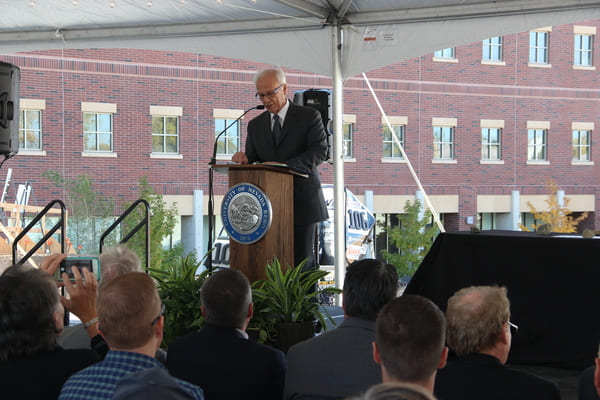
"The new building was absolutely needed for the College to exist and advance," Maragakis said. "The growth we experienced and the successes we had made it a necessity. The need of the building was always argued based on achievements of the College. Its approval and completion was a complex multi-year project involving efforts and success on many levels: academic, political, fundraising, planning, designing and constructing among others.
"Many people came together from the University and community to make it happen and I am grateful to all. I will never forget the groundbreaking ceremony for the new building. It was the moment I realized that this project was going to happen, that our College can look into the future with confidence and pursue greatness."
The building includes space for all five departments in the College, and it provided a new home for the Department of Computer Science and Engineering—increasing the department’s footprint from 13,000 square feet to 23,000 square feet—while also bringing all of its faculty members under one roof.
“The building has meant the most for us,” Department of Computer Science and Engineering Chair Eelke Folmer said. “We had the least square footage, and we were eager to get more space. With the new building, we nearly doubled our footprint.”

The added space will allow the department to continue to build on its growing reputation: In 2021, it was ranked 28th in robotics by Computer Science Rankings, and it was critical in the University’s designation in 2020 as a Center of Academic Excellence in Cyber Defense (CAE-CD) by the National Security Agency and the Department of Homeland Security.
“We’re very happy with the building. Getting everyone here—in these high-quality facilities—helps build community,” Folmer said. “The building is Manos’s crowning achievement.”
The showstopper of the new building, however, is the University of Nevada, Reno College of Engineering Davidson Foundation ISO-5 (Class 100) Cleanroom. Supported by a mechanical room with 10 independent air and water systems, the cleanroom is a carefully calibrated and maintained laboratory that reduces air contaminants from an average of between 500,000 and 1,000,000 parts per cubic foot in ordinary indoor spaces down to 100. This degree of air purity is unmatched by publicly available laboratories in the state of Nevada, and it is essential for cutting-edge research in biosensing, nanotechnology and advanced manufacturing.

For Electrical & Biomedical Engineering Associate Professor Jeongwon Park, the cleanroom will help push forward his research at the intersection of biomedicine, the “internet of things” and advanced manufacturing. Working at the level of the nanometer (for reference, the width of a human hair is 150 nanometers), his wide-ranging work includes the creation of nano-sensors and devices to help motor skills for those with Parkinson’s Disease, improved ultrasound readings for physicians-in-training and highly sensitive sensors for the detection and identification of airborne chemicals and biological agents. As silicon chips reach their limits in power conversion, he is investigating Gallium nitride (GaN) electronics as a greener, more energy efficient alternative. At every turn, his work is informed by a desire to help people and the environment.
“This cleanroom will allow us to build a state-of-the-art multidisciplinary research laboratory, which will in turn allow the University to emerge as one of the premier world institutes in nano/micro electronics and nanotechnology-enabled research.”
Jeongwon Park on the University of Nevada, Reno College of Engineering Davidson Foundation ISO-5 (Class 100) Cleanroom
“This cleanroom will allow us to build a state-of-the-art multidisciplinary research laboratory, which will in turn allow the University to emerge as one of the premier world institutes in nano/micro electronics and nanotechnology-enabled research,” Park said. “The cleanroom will allow my research group to fabricate nanoelectronic devices, and conduct fundamental materials research, thereby creating a novel platform for nanotechnology-enabled nanoelectronics and sensors.”
Chapter three
Strategic objective: high-impact outreach activities: “from K to gray”
K-12 outreach
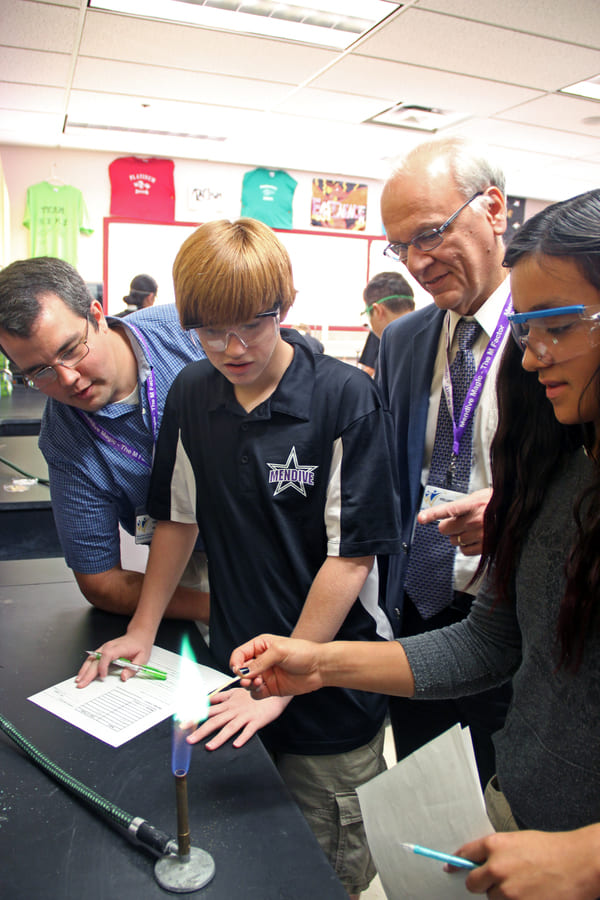
When the University was established nearly 160 years ago through the Morrill Land Grant Act, provisions were made for the “mechanical arts.” Instruction in the mechanical arts has evolved over time to the modern College of Engineering with disciplines ranging from biomedical, chemical, civil, computer science, environmental, electrical, materials science and engineering, to mechanical engineering. What hasn’t changed in that time is the College’s commitment to the guiding principles of the Morrill Land Grant Act to conduct research, provide education and offer outreach activities designed to improve the community it serves.
“Our support of the community starts with students at the earliest stages of their education,” Maragakis said. “Our K-12 outreach programs bring current engineering students into classrooms around the state to inspire the next generation to consider the possibilities in the engineering disciplines—and this is easy to do, because the built world around us is all engineering.”
College of Engineering's K-12 Engagement & Outreach Program Director Meg Fitzgerald oversees all five outreach programs in the College. Each is designed to inspire awe and wonder in K-12 students - whethere that means building trebuchets to launch pumpkins or constructing solar-powered fans. Fitzgerald expanded on the importance of these programs: “The earlier we connect students with engineering principles, the more time we have to show them what engineering includes, how varied and diverse engineering fields are, and how to prepare to become an engineer.”
Outreach programs provide an array of opportunities and ways for students to engage in engineering:
- The Mobile Engineering Education Lab (ME2L) program trains University engineering students to provide engaging activities to foster elementary students’ curiosity about engineering topics. Engineering students visit classrooms and facilitate 1-hour grade-appropriate, interactive lessons for K-5th grade.
- Explorers in Engineering provides interactive after-school engineering lessons taught by Engineering students to 4th through 6th graders.
- On select Saturdays throughout the school year, EPIC Labs invite 6th through 8th graders to campus to participate in hands-on lessons in one of the College’s labs.
- Engineering summer camps provide week-long, on-campus dedicated engineering experiences for 12- to 17-year-old students.
- Mentoring for Achievement & Knowledge in Engineering (MAKE) Nevada is a college-preparation program that strives to increase college enrollment among minority, low-income and first-generation college students.
“I love interacting with kids and helping them express their creativity! When we teach kids about engineering, we’re teaching them that being an engineer isn’t all about math. It’s about creativity and working together.”
Olivia Tahti, senior and Presidential Scholar
These programs are having the intended impact, as recent summer camp participants shared: One camper said, "The counselors were very helpful during my experience because they were great educators and they patiently answered all of my questions." Another added, "The counselors were very helpful as I learned a lot and they were also energetic and fun.” And a third camper enjoyed the rocket project: “I enjoyed all of the experiments, especially the rocket because it was fun to make something that worked really well."
And the Engineering students who serve as mentors gain from the experiences as well. One mentor, Olivia Tahti, said, “I love interacting with kids and helping them express their creativity! When we teach kids about engineering, we’re teaching them that being an engineer isn’t all about math. It’s about creativity and working together. This encourages them to consider engineering as a career!”
Engineering Career Services

One of the most important ways the College serves the community and its students is by creating a bridge between campus and employers. Established by Maragakis, Engineering Career Services provides students with one-on-one career advising and a mentorship program that connects local mentors in engineering and computer science disciplines with students looking to follow in their footsteps. And when students are ready to pursue an internship or launch their careers, the semiannual Engineering Internship & Career Fair provides an opportunity for students to connect with employers both from the private and public sectors.
“The fair is an excellent opportunity for students to see the options available to them to pursue satisfying and meaningful work in our community,” Engineering Career Services Director Joe Bozsik said. “We have a lively engineering and computer science community in northern Nevada, and we’re excited to invite so many exceptional companies, organizations and public agencies to campus.”
During the Fall 2021 College of Engineering Internship & Career Fair, 596 students met 61 employers in the Joe Crowley Student Union. Participating employers offered internship and employment opportunities to students majoring in all engineering disciplines and at all stages of their academic career – from first-year undergraduates to doctoral candidates.
Among the employers was aerospace and national security company Sierra Nevada Corporation (SNC). Ben Damonte, SNC Senior Engineering Manager for Software, attended the fair to speak to students about internships and employment positions on his team.
“I enjoy the opportunity to talk to students and let them know what’s available at SNC,” Damonte said. “Students are often surprised to learn that they’ll be helping with real projects. We don’t have side projects for our interns. They are added to a real development team, working on active projects that support and protect our explorers and heroes.”
“The University and SNC have a very successful relationship. There are a lot of UNR alumni at SNC—including our CEO, Fatih Ozmen—who started out as interns before converting to full-time engineers.”
Damonte can attest to the importance of internships. Before graduating from the University in 2006 with a degree in computer science, he held an internship with SNC. The position turned into full-time employment working on a range of projects that span from avionics, radars and intelligence to navigation and surveillance.
“The University and SNC have a very successful relationship,” Damonte, who now serves on the advisory board for the Department of Computer Science and Engineering, added. “There are a lot of UNR alumni at SNC—including our CEO, Fatih Ozmen—who started out as interns before converting to full-time engineers.”
Distinguished Lecture Series
Established in 2010, the Distinguished Lecture Series, open to the public and free to attend, is designed to provide the community with discussions on important, timely topics from leading figures of national and international prominence. The series has featured former Department of Homeland Security Secretary Janet Napolitano, “Science Fridays” host Ira Flatow, and most recently, PBS President and CEO Paula Kerger.
“The College of Engineering is open to everyone, from K to gray,” Maragakis said. “Our K-12 outreach programs allow our youngest neighbors the opportunity to see the power of engineering, while the Distinguished Lecture Series brings prominent speakers of world-renown to our community.”
Engineering Advisory Board member Sara LaFrance worked closely with Maragakis to make the series a success.
"One of the highlights of my time on the Advisory Board was working with Manos on the Distinguished Lecture Series," she said. "This annual event grew from an idea, to a small technical forum, to a true lecture program featuring such prominent speakers as JB Straubel, CTO of Tesla; Jason Mendenhall, Executive VP of Switch; William Kamkwamba, author of The Boy Who Harnessed the Wind; Mary Cummings, the Navy's first female fighter pilot; Terrell Jones founder of Travelocity and Kayak; Allan Swan, President of Panasonic Engineering, North America. These events drew large live audiences until the emergence of COVID and then in 2020 and 2021, large viewership over ZOOM."
President Sandoval commented on the important role the Distinguished Lecture Series plays in the connection between campus and the community.
“This is an inclusive and increasingly diverse College, understanding that true success will be measured not only by the work, but by the personal paths followed and the successes attained by the people who are doing that work,” President Sandoval said. “The Distinguished Lecture Series brings us all together to hear from the most respected voices of technology, innovation and engineering.”
Strategic Success
The three broad strokes of strategic importance for the College began with a fairly simple statement – a set of goals.
"I provided initially a first document summarizing my strategic objectives and vision as a new dean of the College," Maragakis said. "We then established a system to use this statement as our base and work with all faculty and staff to develop our strategic plan which included a series of strategic objectives. The faculty and staff understood the plan, embraced the vision and the objectives to achieve it."
Chapter four
The man behind the success: reflections from colleagues
A mentor
“I believe ethics are extremely important, as is integrity. If there is strong collegiality in what we do, and if it is done with an abiding sense of respect for our faculty, our students, our staff, our college and our University, then we will accomplish many great things in the future.”
Maragakis in a 2009 Q&A when he was named dean.
Now the Associate Vice President for Research, Ahmad Itani joined the Department of Civil and Environmental Engineering in 1994, the year Maragakis became chair.
“Manos is that rare individual who really excelled in research and scholarship even while working outside of his comfort zone,” Itani said. “He came from Cal Tech, which is known for theoretical research, but he branched out in terms of experiments.”
Together, Maragakis and Itani performed research on a number of projects, including experimentation on the performance of water pipes in a hospital setting during seismic activities. (If after an earthquake, the hospital’s structural elements like its walls foundation are sound but the pipes are leaking, the hospital may have to be shut down anyway, Itani explained.)
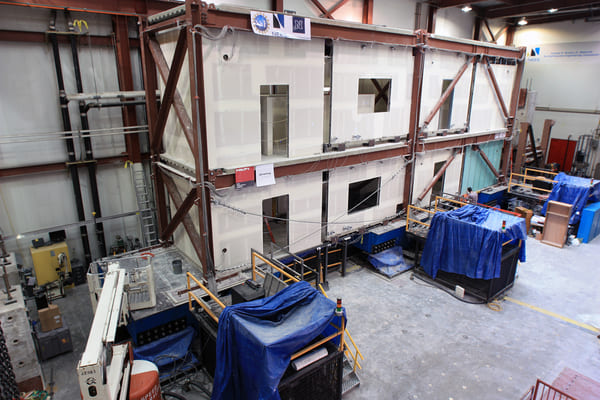
“I was an early career faculty member when he was chair, and he would take me to national meetings to introduce me to the research community,” Itani said. “It was an honor to work with him on so many projects.”
Through this ability to make connections and a reputation for excellence in research, Maragakis earned grant funding for a National Science Foundation Grand Challenge project focused on the seismic response of nonstructural systems. For this project, he led a multidisciplinary research team of researchers and engineers from around the country.
"The grand challenge was a very competitive project and I consider its funding and successful completion one of my greatest achievements," Maragakis said. "At that time it was the largest NSF project funded in the University. I had the opportunity to learn a lot by assembling a leading a group of renowned universities and industry partners and conducting a project that contributed to changing the state-of-the-art. We received major international attention and it contributed to the enhancement or our reputation. I will never forget the many competitive, collaborative and technically challenging experiences and using our renown earthquake lab to conduct testing that drew the attention of researchers from around the world."
Itani added, “It was a crown jewel in a career that saw Manos recognized as a top researcher in terms of NSF funding and expenditures.”
Itani credits his own success in seismic research not only to Maragakis’s direct mentorship but to his ability to build research capacity.
“Manos did a wonderful job increasing the capacity of UNR to hire outstanding senior faculty members,” Itani said, citing Buckle’s arrival in 1999 and the subsequent development of the Earthquake Engineering Lab, which Itani believes helped put the College and the University on the map. But according to Itani, Maragakis’s vision did not end with faculty and facilities.
“You can have the best faculty and equipment, but you have to have good staff, too,” Itani said. “Technicians help faculty reach their goals.”
For Itani, this combination of increased capacity, strong support staff, and opportunity to perform high-impact research on competitive grants prepared him to play a critical role in the safety of the San Francisco-Oakland Bay Area Bridge.
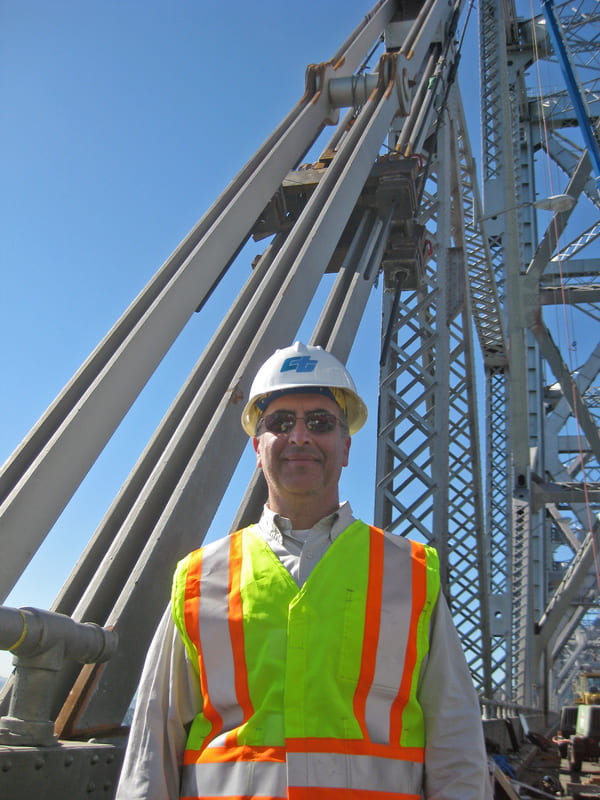
“With the new facilities, I could test large scale structures like the Bay Bridge,” Itani explained, “and develop guidelines for the Bay Bridge seismic retrofit.”
But Itani is quick to note that Maragakis’s mission always included student success.
“He increased enrollment, and with it, advising and mentorship of students,” Itani said. “Differential tuition was really important for helping build instructional labs to mentor students by hiring more TAs. And this is an important point: You can have funding from NSF for research equipment, but differential fees are key for expanding undergraduate education.”
The holistic approach to the College is, Itani believes, the legacy Maragakis will leave: “Excellence in teaching, discovery, and research,” Itani said. “[His stepping down] is a big loss for the University, and it is important to honor Maragakis and his contributions.”
Professor Ian Buckle, who served as the director of the Earthquake Engineering Labs, worked closely with Maragakis to develop the world-class facilities capable of diverse applications of testing large structures to make them safer. He echoes Maragakis's sentiments about team and the importance of working together.
Buckle said that he learned from Maragakis "that people matter. With the right people, creative ideas and resources will follow. He recruited and hired me in 1999. A decision I have never regretted."
"As Civil and Environmental Engineering Chair, and later as Dean, he totally supported my efforts to propel Earthquake Engineering at UNR on to the world stage and keep it there, with unparalleled experimental facilities. This we have done and even today we are close to commissioning the 400-ton soil box and dedicated shake table for large-scale experiments in soil-structure interaction. This has never been attempted before at this scale in the U.S., and if successful will cement our position as the preeminent U.S. laboratory in earthquake engineering. Thank you, Dean Maragakis!"
With Maragakis stepping down, Buckle said his legacy as Dean, something people will remember him for, will be "lifting everyone’s boat. To the point where every department in the College now has an active, research-led, teaching program."
A leader in the College
“When Manos came in as dean, it was fireworks,” Folmer, who joined the University in 2006, said. “He had passion and a clear vision for the College.”
That vision for the College can perhaps be summed up in a single word: Excellence.
“For Manos, ‘Excellence’ is a statement of purpose,” Sally Casas, Maragakis’s Executive Assistant, said. “He always says, ‘If we’re going to do something, we have to do it well.’ These standards show in the way the College is today. This focus on excellence is Manos’s influence.”
Through a desire to innovate and to excel, Maragakis quickly showed he was open to new ideas to support the College. Casas herself led the charge to advance the communications efforts in the College.
“We didn’t really have PR materials then,” Casas reflected. “Our newsletter was in black-and-white, and it looked like it was from the 1960s.”
When Casas brought these concerns to Maragakis, he gave her the greenlight to develop new materials, including the Nevada Engineering magazine. Since its first edition in 2009, the magazine has grown to a 32-page annual full-color publication with a print run of 12,500.
Casas’s experiences founding the magazine are part of a common theme described by those who know Maragakis’s leadership style best.
When Krishna Pagilla was conducting his first search for a faculty member in his role as chair of the Department of Civil and Environmental Engineering, he had a list of three finalists who were all going to be in high demand. Believing that he would wind up losing all three if he had to make offers sequentially and go through negotiations individually, he shared his concerns with Maragakis.
“Manos said, ‘Offer it to all three of them,’” Pagilla recalled. “I said, ‘What if they all want to come?’ He said, ‘We’ll create a position for them.’ That is what it is like to work with Manos: If you have a good opportunity, Manos will support you.”
Although Maragakis and Pagilla both come from the Department of Civil and Environmental Engineering, Pagilla is quick to point out that Maragakis always looked out for the whole College: “He has not played favorites with civil, not even once. I tried!” Pagilla said with a laugh, “but it didn’t work. In the six years I have been here, I haven’t heard anything negative about Manos from anyone who has known him for a while. That is the hallmark of character—you might disagree, but he never rubbed anyone wrong, and he was never hurtful.”
“He has an ideal leadership skill: He takes the blame, while giving credit. And this is because, on the inside, he’s a person who really cares. He cares about everybody, and he deeply cares about the College.”
Eelke Folmer
Folmer expressed similar sentiments: “I really trust him. When we run into difficult situations, Manos will take care of it. He has an ideal leadership skill: He takes the blame, while giving credit. And this is because, on the inside, he’s a person who really cares. He cares about everybody, and he deeply cares about the College. He is a great guy who takes care of his admin staff. I respect him for that."
Shelly Madalinski, former Fiscal and HR Officer for the College, corroborates Folmer’s assessment.
“He has the ability to pick the right people for the right jobs. Then, he is hands off—in a good way,” Madalinski said. “He trusts me to make decisions, and he encourages exploring new ideas while allowing his staff to grow professionally.”
In addition to laying the foundation for the success of his staff and faculty professionally, Maragakis’s tenure as dean will also be remembered for the human touch he brought to his work. Casas, Madalinski, Folmer, and Johnson all remarked on his sense of humor—“he has a great sense of humor and knows when it’s appropriate,” Madalinski said—but Casas got to the crux of the matter:
“We are all here to work and do a job, but he’s very supportive when there’s family matters,” Casas said. “As a single mom, I was the only one who could stay home when my son was sick. He was always understanding and supportive. He is down to earth and approachable. He’s a really good guy.”
Engineering Advisory Board
Maragkis, cognizant of the need to engage engineering industry and community, developed the Engineering Advisory Board. It has been one of the important connections for faculty, students and administrators as Maragakis pursued and developed job creation and economic development programs in Nevada.
"It is such a different College today than it was when Manos took the helm," Sara LaFrance a long-time member of the advisory board, said. "It has been truly transformed. During my time as a member of the Engineering Advisory Board, Manos was the acting dean and then the appointed dean under whom I served. Under his leadership, the number of students in the College increased, their outcomes rose, the major and minors being offered expanded and the reputation of the College grew. The culmination was the completion of the new Engineering building which has elevated the College’s image and provided much needed quality space."
Jeff Ceccarelli, who also served on the advisory board, agreed.
"Under Manos's leadership the College of Engineering has prospered," he said. "Enrollment has doubled, national rankings and recognition have increased significantly, he has created an incredible team of faculty and staff, and possibly the crowning achievement (and a big part of his legacy) is the completion of the new Pennington Engineering Building. We congratulate him on his well deserved retirement from the Dean's position. He leaves big shoes to fill."
A collaborator and builder
Marc Johnson, who served as the 16th president of the University from 2012 to 2020, joined the University in 2008 as the Executive Vice President and Provost. In both of these roles, he worked closely with Maragakis as he pursued his vision for the College.
“Manos is a very driven person with high expectations. He demonstrated pride in the College, which under him, was highly productive,” Johnson said. “As dean, he gained the respect of his faculty, and he did an excellent job forming an advisory committee—the most effective on campus. He had a way of explaining to the engineering world and industry partners how the College could help them.”
Maragakis’s ability to engage industry and the community was key to the pursuit of a new engineering building, resulting in what Johnson described as “a groundswell of support for the new building, from industry and community partners.”
The vision of the building became a reality, though, when Maragakis was able to demonstrate how it would dovetail with the objectives of the economic initiatives for the State of Nevada and the objectives of the University.
“When Governor Sandoval visited the engineering complex, Manos showed him how the College was important for the state’s economic development plan,” Johnson recalled. As a result, the state provided half the funding for the building. The rest of the funding came from University sources and private philanthropy, including a lead gift from the William N. Pennington Foundation. “It was a big team effort, but it all started with Manos’s appeal. The William N. Pennington Engineering Building is a big deal for the whole campus, and it all worked out well because it serves the objectives of so many different people.”
As President, Johnson was also able to observe Maragakis’s willingness to make connections with other deans and other colleges.
“He took a leadership role among the deans,” Johnson said. “He helped new deans learn how to operate within the counsel of deans, and he was a leader in the sciences and more technical areas. He got along well with everyone, and he initiated many joint projects. He reached out to Journalism to discuss ways to improve science communication, and he worked with the Medical School. He was always willing to cross disciplines to come up with useful programs.”
“Through his dedication to the College of Engineering and earthquake engineering in particular, we have an international jewel on campus.”
Marc Johnson
This desire to collaborate and build together is, Johnson remarked, what he will remember about Maragakis’s term as dean.
“Cal Tech grads can go anywhere. Over the years, Manos probably gave up other opportunities,” Johnson said. “But he stayed to develop what we have here. Through his dedication to the College of Engineering and earthquake engineering in particular, we have an international jewel on campus.”
Maragakis was awarded the 2017 SIR award from the Nevada Chapter of the Associated General Contractors. The prestigious award, named for the AGC motto, “Skill, Integrity and Responsibility,” honors the individuals and organizations that have made outstanding contributions to Nevada, quality of life and the construction industry.
Manos reflections
True to form, though, when Maragakis reflected on his own tenure, he confirmed Folmer’s assessment that it is of the utmost importance to him that others receive the credit they deserve.
"It is indeed a unique feeling of accomplishment and satisfaction to see so many strategic initiatives completed with success, but it is even more gratifying to see almost all of my colleagues too are in a much better shape and have achieved more than I had when I was at the same stage of their careers," Maragakls said. "To me this is the real indication of success. I am so grateful to look back and think that I have contributed to them taking advantage of their talent and progressing so impressively. After all, all administrators should work hard to create enthusiasm and an environment in which everyone will have an opportunity to use their talents and maximize their success."
As Ian Buckle observed, Maragakis "raised everyone's boat," not just his own, by bringing his balance, wits and endless energy to the College and creating a culture of success that permeated the College of Engineering.
“I would like to thank the University Administration during my tenure, including President Glick, President Johnson and Provost Carman. Their support made our successes possible. When my successor is selected, we look forward to the leadership of President Sandoval in continuing the success we have built, just as he provided steadfast support to the College when he served as governor,” Maragakis said. “Thank you, too, to the students, faculty, and staff who have shared in this vision for the College and embraced new initiatives to make them successful. We are all here for our students, and all of my colleagues are committed to their first-class education. As a result, our alumni excel in the engineering and computer science disciplines all over the world. I am proud of their accomplishments on campus and beyond.”
Listen to Dean Manos Maragakis on the Sagebrushers podcast with President Sandoval



